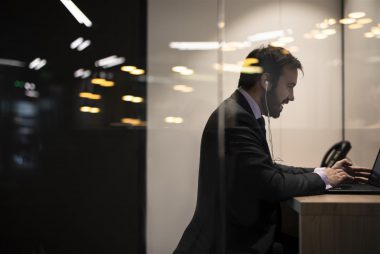
An increased focus on health will lead to the accelerated implementation of new workplace strategies. More flexible spaces, protective barriers, sanitization systems and biophilic design are just some of the elements that will characterise the offices of tomorrow.
The coronavirus pandemic will have an impact on different aspects of our lives, and one area that will be most influenced in the short, medium and long term is the workplace.
“The office will continue to be the heart of the expression of corporate culture and identity,” says Philippe Sourdois, Managing Director of Tétris Italy. “The office is a place of coming together, creating a sense of community. No technology, however innovative it may be, can recreate this. But what is destined to change is the way the workplace is conceived.”
Cultural changes: the balance between physical and virtual
“What we will see is a new balance between virtual and physical, between safety and efficiency, between work and private life,” continues Sourdois. The workplace will take on new meaning and should be a place where employees feel safe, where their physical and mental wellbeing is protected.
It will be necessary to take into account a number of factors that are changing people’s behaviour: social distancing, greater attention to health, and an increase in the use of technology that allows remote work.
Rethinking workspaces in the short and medium term
In the short term, companies will be called upon to ensure safety and a safe distance between their employees by introducing hygiene and safety protocols and adapting workstations according to government guidelines, including physical barriers, spacers and careful sanitation of environments. For example, UV lights to sanitize the office overnight and the appropriate maintenance of air conditioning systems.
“In terms of layout,” says Tiziano Betti, Head of Design for Tétris Italy, “there will be no significant changes but the space will be at 30% to 50% of its total occupancy, with reduced staff access and increased remote work.”
Technology to reserve spaces and avoid desk sharing will be implemented, and mobility in the office will also have to be coordinated to manage circulation flows and raise employee awareness around new ways of using the space.
Meeting rooms and common areas will be reorganised and it will be necessary to manage access to avoid overcrowding. “Sensors will become crucial in not only detecting the presence of people, but also for measuring the health of the person,” explains Betti.
In the medium term, when employees return to the office more frequently and regularly, occupancy will increase and workspaces will have to be reconfigured so as to protect employee psycho-physical wellbeing.
From reception to operational areas, the geometry of the spaces will be reviewed by introducing touchless systems and flexible furnishing solutions to reconfigure the spaces according to new needs. “The materials themselves will even undergo some changes, smooth surfaces will be preferred, which can be easily sanitized and do not degrade with the frequent use of disinfectants,” continues Betti.
In reception areas, the distance between the visitor and the receptionist will increase and waiting areas will be organised for fluidity and openness. Phone booths and informal meeting rooms will be reconfigured, transforming them into individual workstations to regain privacy and concentration.
“As the situation evolves and new needs emerge, dynamic hub spaces or clubhouses can be introduced to support teamwork when it cannot be managed remotely,” says Betti.
From biophilic design to “virtual engagement”
The different work areas will be delimited by introducing dividing panels, lockers or even natural elements.
“Biophilic design will be one of the trends that will most characterise the office of the future,” explains Betti. The introduction of nature within the workplace fosters a general sense of wellbeing necessary to make employees feel safe. This is a sustainable solution, also in terms of costs, with a low environmental impact that improves air quality at the same time.
According to Sourdois, the growing affirmation of ‘virtual engagement’ and the need for innovation will also play a fundamental role in the design of the post-COVID-19 office.
With the reduction in travel, meetings will become increasingly virtual. It will become essential for workplaces to be equipped with cutting-edge technologies supported by strong connectivity to enable remote communication and collaboration. “Meeting spaces will be equipped with video-conference systems and digital platforms, without neglecting the issues related to acoustic design,” says Betti.
The workplace of tomorrow will be inclusive in its design, creating a comfortable and familiar environment where people want to gather and that, even in this period of continuous adaptation, primarily supports their health and safety.
New parameters for the office of the future
In the coming months, it will be necessary for companies to assess their future needs in terms of resources and reorganisation of company systems and workspaces, also taking into account the possible scenario changes.
“However, we can predict that wellbeing, flexibility and changes to corporate culture will be the main factors that will define the new parameters of the offices of the future,” concludes Sourdois.
